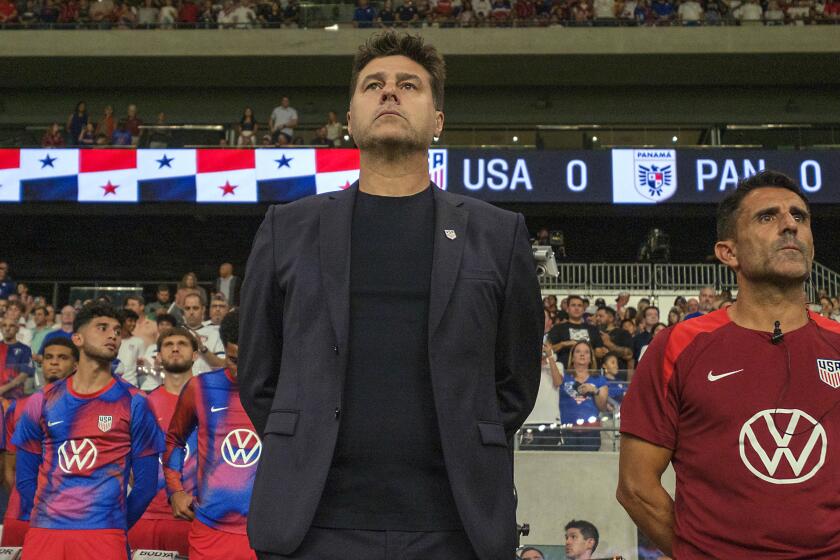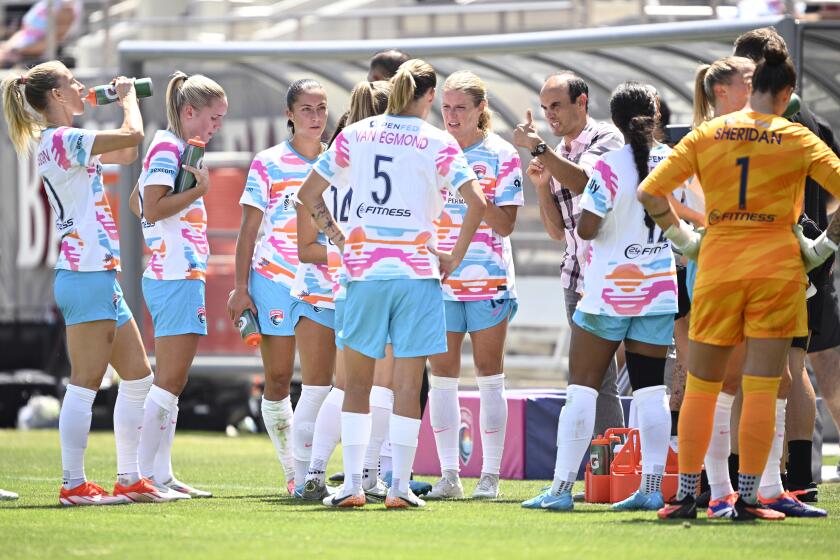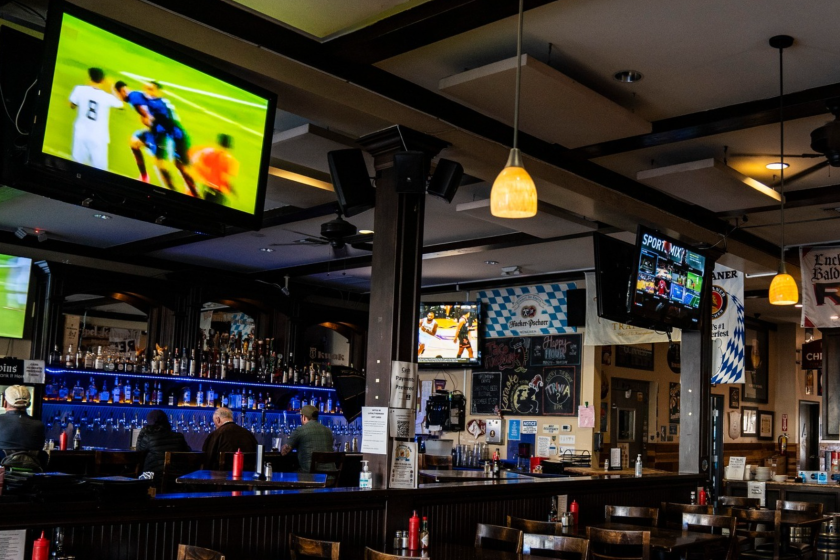Major League Soccer Surpassed Its Goals
BOSTON — When almost 35,000 people stand for two hours or more in the pouring rain to watch an event that has no local connection, something must be going on.
It can’t be curiosity. The citizens of New England have had all year to figure out whether they like Major League Soccer.
It can’t be simply to see the game, because that could have been done without being soaked to the skin and all but frozen. Washington D.C. United’s 3-2 overtime victory Sunday over the Los Angeles Galaxy could have been viewed quite comfortably at home on network television.
So why did 34,643 trek to Foxboro Stadium for MLS Cup ‘96, the league’s championship game? Could it be that MLS has been correct all along in its belief that there is a vast, untapped sports audience out there waiting for the right product?
Jonathan Kraft--yes, of that Kraft family--believes so. Clark Hunt--yes, of that Hunt family--believes so. In fact, the Krafts and Hunts are in the forefront of what is rapidly turning into a unique and previously unimaginable alliance. The NFL and MLS have found common ground, and American sports might never be the same.
The Krafts own the New England Patriots. Football is their winter game. They also own the New England Revolution. Football (the original kind) is their summer game. Same goes for the Hunts, who watch their Kansas City Chiefs at Arrowhead Stadium for half the year and their Kansas City Wiz in the same stadium for the other half.
And in case they get bored, the Hunts head up to Columbus, Ohio, and check on the Crew, their other MLS franchise.
Strange as it may seem, the NFL and MLS are getting along just fine. One reason stands out: NFL owners are building new stadiums that cost millions. If they are empty half the year, the economics don’t make sense. But if they build them to soccer specifications, MLS can give them instant tenants.
Which is why the New York Giants are moving toward accepting the proposal of the New York/New Jersey MetroStars that the Giants Stadium field revert to natural grass year-round.
Which is why talks involving Microsoft co-founder Paul Allen and the Seattle Seahawks about a new stadium also are involving MLS officials.
Which is why before expanding into Chicago, MLS is in close contact with the Bears over the future of Soldier Field.
Which is why if and when Los Angeles ever gets an NFL team again, it could conceivably share its stadium with an MLS team.
Another factor in the developing friendship between the leagues is MLS’ now-proven ability to reach beyond white, middle-class, aging America. Listen to Kraft, speaking last Friday about the anticipated attendance for Sunday’s final:
“It’s not going to be a predominantly white, male audience, but rather it’s going to be an audience made up of Caucasians, Latinos, African Americans, Asian Americans,” he said. “And not everybody will be over the age of 35 or 40. It’s going to be [made up of] a lot of children, boys and girls who play youth soccer, to maybe guys in their 30s who played in college and high school, and then older people who were immigrants to this country and who have a special appreciation for the sport.
“I think what our league is all about and what the future of American sports is all about [is to be] truly a mirror image of America, a coming together and having bridges between people fall down as they watch a sporting event together.”
It is a difficult balancing act that MLS investors have undertaken. They are trying to reach two dissimilar audiences by using a common denominator--soccer. They want, and indeed have succeeded, in attracting ethnic fans, largely Latino but with a good sprinkling from all over the world. And they also are working to attract the youth of America, youngsters who are bored with baseball and want something livelier, more exciting, more 1990s than 1890s.
A check of MLS stadiums this season shows that the league has started out well in pursuit of those goals. In cities such as Los Angeles, Washington and New York, for instance, ethnic fans are coming out in record numbers. In cities such as Columbus and Kansas City, young fans predominate.
The league attracted about 3 million in its first season. Not a huge number but a respectable one for an inaugural season. Last week, PepsiCo became the league’s ninth corporate sponsor. MLS had a reported $50 million in sponsorship commitments over the next four years before the Pepsi deal was announced Friday.
Doug Logan, the league’s commissioner, believes MLS is on track to become the country’s fifth major professional sport.
“We did what we said we were going to do,” he said of the league’s first season. “We said we were going to put out on our playing fields high-quality, attractive, aggressive soccer, and we did. We said that people would come, and they did--to the tune of 45% higher than what we had thought. We said we would do it prudently. We started out with a sensible business plan and we stuck to it. We said we would put out an honest and affordable product, and we have.
“Second, we opened our arms to new Americans and they have responded with glee. Over 40% of our audiences nationwide are ethnic first- or second-generation Americans, mostly Latinos. It’s rather interesting on a game-by-game basis to see people who otherwise would not come together to share an experience enter our stadiums and--reservedly at first, looking around and saying, ‘You know, I’m not sure these are the people I would hang out with,’--all of a sudden come together during the course of the season for the common purpose of cheering their team.
“We have appealed to the best in the American psyche and we’ve appealed to it in the following way: We’ve exemplified tough competition, fair play, access to all and inclusion for all races, genders and economic classes.”
Alan Rothenberg, the league’s chairman and founder, said the owners realize that there is a long way to go before they can claim success, despite the accomplishments of 1996.
“I think the feeling of all the owners when we met yesterday was obviously, ‘It’s wonderful, it’s a great success,’ but they’re a very intelligent, sober-minded, feet-on-the-ground group of people,” Rothenberg said Sunday. “They know this was only the first year and this is hardly any time to declare victory and go home. It’s time to do more.
“We have decided to take the money we didn’t lose that we had expected to lose and put it back into the league and use it, on top of the player-acquisition budget that was already there, to bring in an additional group of high-quality players.
“Play was excellent this year. It was very competitive, very entertaining and it certainly improved as the season went on, which is understandable since we basically had 10 expansion teams. Our obligation is to continue to improve the product year by year.”
With that in mind, MLS sought and received permission from the U.S. Soccer Federation on Sunday to increase the number of foreign players on each team’s 20-player roster from four to five. The USSF agreed, but only on condition that the five-foreigner rule be limited to three years, after which it will revert to four.
“That was just to make it clear that we’re not deviating from it being a predominantly U.S.-player league, but that in the short term, if we want to improve the quality of play, we can’t do it based on the pool of American players.”
As for expansion, Rothenberg said it will come later rather than sooner.
“We’re not in a hurry to expand,” he said. “We want to solidify our base, both operationally and from a playing standpoint. And we also want to make sure we put forth the maximum effort to get the proper stadiums any place we go. We did the best we could this year. Some situations were excellent but some of them were not.”
(BEGIN TEXT OF INFOBOX / INFOGRAPHIC)
MLS at a Glance
* Champion--Washington D.C. United
* Runner-up--Los Angeles Galaxy
* Coach of Year--Thomas Rongen, Tampa Bay
* Most Valuable Player--Carlos Valderrama, Tampa Bay
* Top Goal Scorer--Roy Lassiter, Tampa Bay
* Top Defender--John Doyle, San Jose
* Goalkeeper of Year--Mark Dodd, Dallas
* Rookie of Year--Steve Ralston, Tampa Bay
* Best 11 Players--Mark Dodd, Dallas; Eduardo Hurtado, Robin Fraser and Mauricio Cienfuegos, Los Angeles; Roy Lassiter and Carlos Valderrama, Tampa Bay; Marco Etcheverry, Washington; Preki, Kansas City; John Doyle, San Jose; Roberto Donadoni, New York-New Jersey.
TEAM RECORDS, ATTENDANCE*
*--*
Team W-L HG Total Avg. Galaxy 19-13 16 462,655 28,916 MetroStars 15-17 16 382,360 23,898 New England 15-17 16 304,392 19,025 Columbus 15-17 16 303,202 18,950 San Jose 15-17 16 275,712 17,232 Dallas 17-15 16 256,173 16,011 D.C. United 16-16 16 244,489 15,281 Kansas City 17-15 16 206,421 12,901 Tampa Bay 20-12 16 186,856 11,679 Colorado 11-21 16 164,413 10,276 Overall 160 2,786,673 17,416
*--*
* Regular season.








